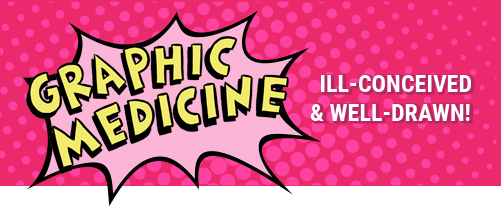Class 1: Introduction to Graphic Storytelling
Introduction:
In this class students learn about the field of Graphic Medicine and explore the relevance of comics to health care. Students consider definitions and characteristics of comics, the different roles of pictures and text, ways in which images and words interact, and how comics show us things that cannot be said.
Suggested readings introduce students to visual and textual aspects of the comics format and graphic storytelling. The readings also help students begin a conversation about how comics work—what their features are; how one reads a comic; what the meaning of various symbols, lines, shapes, etc. is; how words and images function together; what can be done via comics that cannot be done with words alone; how the passage of time is communicated; how emotions are depicted, and so on.
The chapters from Scott McCloud’s classic book, Understanding Comics, outline the vocabulary of comics and explain what the comics medium is, how it works, and why it is different from other literary forms. This reading is essential for anyone seeking to understand comics. The article by Green and Myers discusses the concept of Graphic Medicine by presenting the uses and relevance of comics to medicine and medical education. The webcomic by Luke Pearson describes his fears about his own mortality and his personal relationship to health and illness.
Students begin the class by drawing a simple self-portrait in the style of comic artist Ivan Brunetti, using circles, triangles, and rectangles on a 4 x 6” notecard. Instructions for this activity are found in Lynda Barry’s “Ivan Brunetti style” from Syllabus: Notes from an accidental professor (p. 17) and in Green’s “Brunetti Style” video. Afterwards they exchange their self-portraits with the person sitting next to them, and learn about one another. Students then introduce their partner to the entire group, showing their partner’s self-portrait and telling the class about this person.
Learning how to create a daily visual diary is a second class activity. Students write and draw in a composition book aimed at self-reflection, and share some of their entries during subsequent class discussions. It’s a great way for them to become more careful observers of the world, and promotes habits of awareness, reflection, and documentation. To draw their first entry in their visual daily diaries, students watch Lynda Barry’s “Six Minute Diary” video, use the handout “Keeping a Daily Diary,” and read Barry’s “Your Daily Diary” in Syllabus: Notes from an accidental professor.
Class Resources
- McCloud, Scott. Understanding Comics: The invisible Art. New York, NY: Harper Perennial, 1994, chapters 1 and 2 (pp. 1—59).
- Green, Michael J. and Kimberly Myers. “Graphic Medicine: Use of Comics in Medical Education and Patient Care.” BMJ 2010, vol. 304: 474—77. [PubMed]
- Pearson, Luke Pearson. Untitled webcomic. http://lukepearson.com/Comics/Nobrow-8
- “Comics Terminology”. Teaching Comics: Study Guides and Handouts on The Center for Cartoon Studies. https://www.cartoonstudies.org/wp-content/uploads/2014/06/terminology.pdf
- Abel, Jessica and Matt Madden. “What is a “Graphic Novel?” Drawing Words & Writing Pictures. October 22, 2012. http://dw-wp.com/resources/what-is-a-graphic-novel/
- Barry, Lynda. “The Style of Ivan Brunetti.” In Syllabus: Notes from an Accidental Professor. Montreal, Quebec: Drawn & Quarterly Publications, 2014, p. 17.
- Michael Green’s Graphic Medicine Channel. “Brunetti Style.” YouTube video, 2:03, posted July 2017. https://www.youtube.com/watch?v=jIlNtjsOKRo.
- Barry, Lynda. “Your Daily Diary.” In Syllabus: Notes from an Accidental Professor. Montreal, Quebec: Drawn & Quarterly Publications, 2014, p. 61.
- Keeping a Daily Diary (PDF)
Discussion Questions
- Discuss Luke Pearson’s untitled webcomic and consider the following questions:
- What happens in the story? How do you know? In what order, do you read this?
- What is the role of text? What is the role of images? How do text and images interact?
- How does the artist depict the passage of time?
- How does Pearson differentiate between actual and imagined events?
- What physical symptoms are depicted? How does Pearson visually depict pain or dizziness or nausea?
- What emotions are expressed? How does the reader know these are the emotions?
- What does the story tell us about illness and anxiety?
- What is the function of various comics features used (motion lines, “emanata,” speech bubbles, thought balloons, gutters, etc.)
- What is accomplished that is difficult to do with a standard text-only story?
- Comics have been known by many names, including cartoons, graphic novels, and graphic narratives. For the purposes of this course, we use the term “comics.” There are a variety of competing definitions of comics, but generally, they share the common features of including pictures, containing words, and telling a story sequentially.
- How does McCloud define comics?
- What are some common characteristics of comics?
- In what ways do comics make the concrete into something more abstract? What are the consequences of such abstraction?
- What role do icons/symbols play in providing meaning in comics?
- Graphic Medicine
- Steven Keewatin Sanderson, a self-taught animator and illustrator and creator of Journey of the Healer, was one of the keynote speakers at the 2015 Graphic Medicine conference in Riverside California. Sanderson said that when he first heard about comics and medicine, he thought these two things didn’t fit together—like pudding and mustard. What do you think he meant? Do you share that initial impression? How do you think comics might overlap with medicine?
- Discuss what is meant by the term “graphic medicine.” How do Green and Myers define it?






